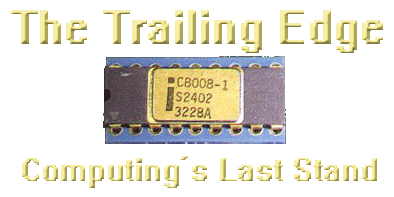
Five Most Wanted | ||||
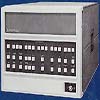 | 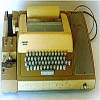 | 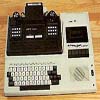 |  | 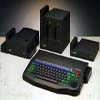 |

| ||||||||||
Ken Barbier The real grabber was what appeared to be an 8-track tape cartridge plugged into the side of the machine. As the salesman was quick to point out, the cartridge didn't contain tape - it held the BASIC language in read-only memory (ROM). And, in the future, other languages and utility programs would become available in the same format, so that they could be instantly swapped with the BASIC, simply by unplugging one cartridge and plugging in a new language. This feature, combined with a really extensive keyboard providing instant access to graphics as well as alphanumeric characters, led me to fall instantly in love with the Sorcerer Computer. This was in April '78 at the PERCOMP convention in Long Beach, California. Sorcerer production was scheduled to begin in June. It was not until early in August that a new Sorcerer arrived on my doorstep. Read on and you will see if I think the wait was worth it. Instant ComputerLittle more than a year has passed since the initial deliveries of the first "take it out of the box and turn it on" microcomputer, the PET from Commodore. Shortly on its heels arrived the TRS-80 from Radio Shack. These computers are now readily available, and are supported by a mountain of software for both game playing and serious business use. Neither of these machines is perfect. The PET has a funny little keyboard that may be alright for one-finger pecking, but is pure agony for anyone who can type. The PET does include an adding machine/calculator type keypad, however, which greatly speeds up numeric data entry. The TRS-80 has a real keyboard, but lacks the numeric keypad. The CRT display is TOO LARGE at 12" and has too few lines displayed at any one time. With Level 1 BASIC the TRS was alright for game playing, but was severely limited for any serious use. With the optional Level 2 BASIC installed, the Radio Shack computer is a fine machine for home or business use. Both of these micros are readily expandable, but the choice of the IEEE 488 interface bus for the PET is questionable. This bus convention is found on expensive laboratory equipment, but it is not compatible with the peripherals available to the typical personal computer user.
Enter the SorcererExidy, Incorporated, a leading manufacturer of arcade type video games, aware of the shortcomings of these first two personal computers when it developed the Sorcerer, took full advantage of their experience. Exidy combined the really great graphics capability of the PET with the expansion flexibility of the TRS-80 and added its' own super feature, the Rom Pac. The Sorcerer has a full typewriter keyboard with both upper and lower case letters displayed on the CRT, and when the word processing system becomes available, a quick swap of the cartridges will convert the machine into a smart typewriter. with the addition of a hardcopy device, of course. Hardware FeaturesAnticipating this type of use, a 25 pin connector has been provided for 8-bit parallel input/output (I/0), so that a printer or typewriter type terminal can be instantly attached for hard copy. Also sharing the back panel of the Sorcerer's enclosure are a second 25 pin connector providing access to the dual audio cassette interfaces as well as an RS-232 serial data line for communicating with remote terminals. Completing this array of interfacecapability is a 50 pin card-edge connector which can be used to attach an S-100 (Altair type) expansion chassis. The keyboard on the Sorcerer is one of the machine's outstanding features. Not just because it has a comfortable, solid feel, and features both upper and lower case. Actually, some keys have five distinct functions: upper case, lower case, graphic character, user defined graphic character and single keystroke entry of BASIC statements. This latter feature allows a non-typist to key in a BASIC program about asfast as a typist could. Access to each of the five function levels is through the use of the SHIFT and GRAPHIC keys. With neither pressed you get a lower case letter. SHIFT gives upper case, as on a typewriter. GRAPHIC provides access to the 8 by 8 dot matrix built-in graphic characters. SHIFT and GRAPHIC keys together provide access to a user defined 8x8 dot character, provided he has previously entered the bit pattern into RAM memory. When BASIC is running, or is in the command mode, the combination of the GRAPHIC and a letter key will produce a complete BASIC statement or command (GOTO, CLOAD, etc.). In spite of this, BASIC still has access to the graphics characters. If you want your BASIC program to display a graphic character, it would be entered between quotes (as in: LET A$ = "^" in which case the GRAPHIC key in combination with another key will produce the graphic character rather than the BASIC statement. Hard SoftwareComputer programs used to be referred to as "software." However, with the introduction of higher level languages in ROM, "firmware" is a more descriptive term. Programs on tape can still be called "soft." The nice thing about firmware is that it is instantly available. No five minute wait for a tape to load.
In addition to the BASIC language in Rom Pac, the Sorcerer comes with an extensive monitor program in ROM on the CPU board, where it is always available. This monitor handles all the I/0 for the Rom Pac language, so it can be used to reassign the input or output operations for BASIC in the event a peripheral terminal or printer is used. At the machine language level the monitor provides the usual operator access to memory for dumping or changing memory locations. There are also commands for reading and writing to either of the tape interfaces, and even tapes written by BASIC can be loaded from the monitor. A "batch" mode is also available, which allows the operator to create a tape containing a series of commands, which the monitor can then execute one at a time. For example, assuming two cassette drives are used, with the motor on-off controls connected, a batch tape can be created which will load a BASIC or machine language program, run the program, return to the monitor batch mode, load another program, execute it, etc. Using this feature, programs which are too big to fit in memory at one time can be loaded and run in sequence without operator attention. The BASIC supplied with the Sorcerer is an 8K version which is more powerful than Radio Shack Level 1 but falls short of PET or Level 2 capabilities. It has no double precision option, PRINT USING, EDIT, or AUTO line numbering. The lack of double precision can seriously limit business use of the machine. Expansion: OptionalWhile it is nice to know that the connector is there on the back panel, and that an expansion chassis is available to connect it to, the features already included with the Sorcerer make you wonder if expansion will ever be required. RAM can be expanded to 32K on board. Two tape decks with automatic motor control plug right in. An 8 bit parallel input and an 8 bit parallel output port are built in along with a bidirectional RS-232 interface. These features permit a computer system configuration quite capable of handling serious business data processing without expansion. If you insist... go ahead and add a couple of disc drives and a speech synthesizer and an X-Y plotter, or any of the other S-100 bus compatible peripherals already on the market. Sorcerer is ready when you are! The "So Who's Perfect?" DepartmentProfessor Gilmauch Crimwaddy's Second Law of Static Dynamics states that "Version 2 (of anything) is the first version that really works." This is quoted here not to challenge Fundamentalists or the First Book. It is merely to point out that when you insist on ordering a machine before it is even in production, you can expect to find something wrong somewhere. Let's see what one customer found. My Sorcerer was the fifteenth off the production line. It was unpacked and placed on the kitchen table. A Hitachi 9" monitor was connected to the VIDEO OUT jack. No monitor is included with the Sorcerer, allowing the user to select a screen size compatible with his glasses prescription. The BASIC Rom Pac was inserted and the POWER switch activated. Sorcerer came up running, and informed me that I had 7400 bytes available. The rest of the 8192 bytes of RAM that come with the machine are used by BASIC and the monitor. The 7400 left for the user is plenty. It will take a while to fill them up. The first three weeks of Sorcerer's life were devoted to constant activity. It moved around locally. It took a 500 mile trip in the trunk of my car. It was used by nine year olds and up. It was asked to display its' 30 lines of text on a high resolution monitor and on a cheap TV set. It was required to talk to several different inexpensive cassette recorders. Its interface ports were probed by scope, although real peripherals were not yet available for the acid test. All seems in order. Yet, no one is perfect. The SHIFT LOCK key refused to keep the keyboard in upper case. This is important to BASIC, which will accept strings in lower case but wants statements in upper case. One of the many users discovered that by pressing down and slightly to the right on the keytop it could be made to work reliably. This was the only hardware deficiency with the Sorcerer. It can hardly be called a "failure," merely an inconvenience. There are a couple of minor deficiencies with the "firmware." While a long BASIC listing is flashing past on the screen, the CTRL 0 function does not serve to pause the listing, as the manual implies it should. That covers the problems with the BASIC language. The advertising brochure which I picked up in April stated that the monitor program allowed the operator to examine and alter registers and set breakpoints. The manual that arrived with the computer doesn't mention these functions. Perhaps they are there, but the writer forgot them. If so, he could have been the same writer who neglected to mention how to implement the BASIC USR function, whereby an assembly language routine can be called by a BASIC program. So much for the deficiencies in documentation. This Exidy Sorcerer has been given a really hard workout since it arrived. You have to be a real nit-picker like me to find these few minor problems. It would appear that Exidy, Inc., has disproved the Second Law. Version 1 of the Sorcerer is a near perfect product. Putting Sorcerer to WorkThis computer was acquired for a purpose: to prove (or perhaps disprove) the contention that an under $2000 computer system can earn its keep in a small business environment. No disc drive or expensive printer will be used. No all-encompassing high powered general ledger program will be used. Small businesses of the Mom and Pop variety cannot and will not modify all of their bookkeeping practices to conform to the requirements of the general purpose accounting software packages. There are a myriad of other tasks which a small computer can perform in order to earn its keep. The Sorcerer will be assigned these tasks, one at a time. Within hours of its arrival it had performed the first. As the photograph of the TV set display shows, the computer was used to generate a pseudo-random set of key patterns to be used to master-key a motel. (Burglars please note that the patterns shown are not those actually used.) With two tape interfaces and a printer port built in, this computer can perform real data processing tasks. One of its first assignments will be to generate a customer account data base. In succeeding months it will be required to update the account records and print monthly statements. These tasks are well within the capabilities of the basic machine, with no expansion chassis or disc system required. ConclusionsWith its super set of built in features, the Exidy Sorcerer stands head and shoulders above its competition. But, since it does not come with CRT monitor or cassette tape recorder, it also costs more than the competition. The extra expenditure for the Sorcerer, as compared to the Radio Shack or Commodore computers, can only be justified on the basis of the more serious use of the machine and taking advantage of its special features. This makes the lack of double precision arithmetic and extended features of BASIC all the more serious. Assuming a future upgrade to a 12K extended BASIC, this machine could become a near perfect small computer for business use. As it stands now, it is the best choice for the serious hobbyist or experimenter. |
Site Copyright © 1997 - 2026 David Williams